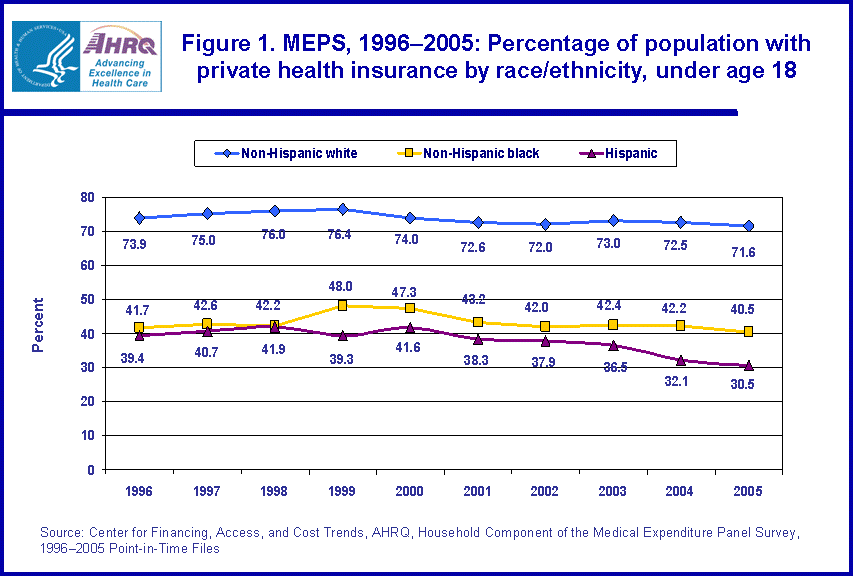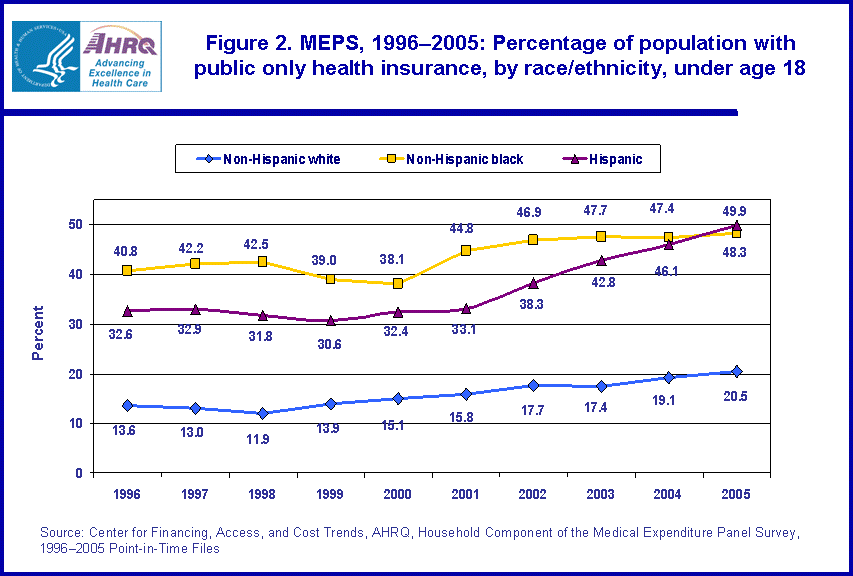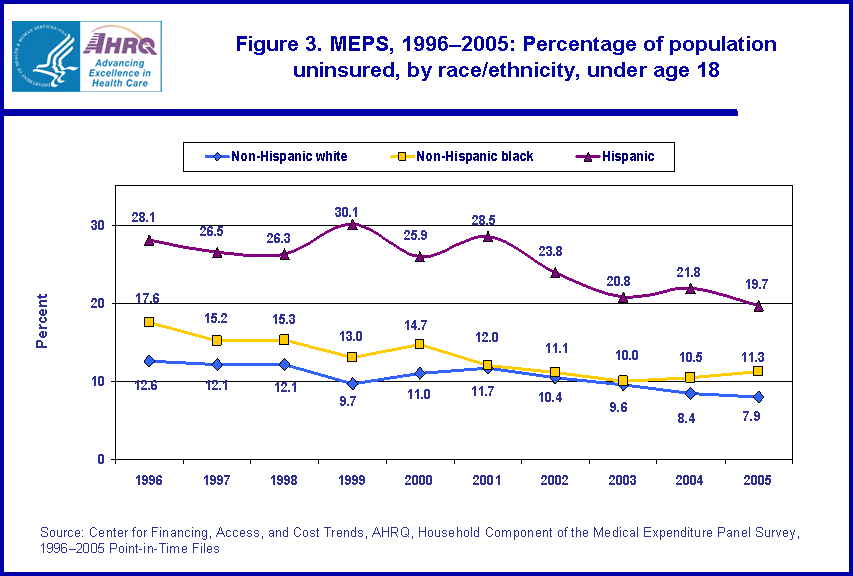
|
|
Font Size:
|
||||
|
|
|
|
||||
STATISTICAL BRIEF #141:
Changes in Children's Health Insurance Status, 1996-2005: Estimates for the U.S. Civilian Noninstitutionalized Population under Age 18
Highlights
- Non-Hispanic white, non-Hispanic black, and Hispanic children's rates of being uninsured dropped substantially between 1996 and 2005. Non-Hispanic white children's rates of being uninsured fell from 12.6 percent to 7.9 percent, while non-Hispanic black and Hispanic children's rates fell from 17.6 percent to 11.3 percent and 28.1 percent to 19.7 percent, respectively.
- In 1996, rates of private coverage exceeded rates of public only coverage for Hispanic children (39.4 percent versus 32.6 percent, respectively). However, by 2005, public only coverage was a far more important source of health coverage for Hispanic children compared with private coverage (49.9 percent versus 30.5 percent, respectively).
- In 1996, Hispanic children were less likely to be covered by public only coverage than non-Hispanic black children (32.6 percent versus 40.8 percent, respectively). The large rise in rates of public only coverage for Hispanic children from 1996 to 2005 more closely aligned their rates of public only coverage with that of non-Hispanic black children by 2005 (49.9 percent versus 48.3 percent, respectively).
Introduction
The State Children's Health Insurance Program (SCHIP), enacted in 1997, expanded eligibility for public coverage to low income children. Previously published findings from the Medical Expenditure Panel Survey indicate that between 1996 and 2002, the percentage of all children eligible for public coverage rose from 28.6 percent to 47.1 percent, and that efforts to improve outreach, simplify enrollment, and retain eligible enrollees in Medicaid and SCHIP likely contributed to increases in the rate at which eligible children enrolled in public programs.*
This Statistical Brief presents updated evidence on trends in children's coverage for 1996 to 2005 by race/ethnicity status, showing that continued growth in public coverage has been a major factor in improving rates of health insurance coverage for children. These changes have been particularly dramatic for minority children.† All differences between estimates discussed in the text are statistically significant at the 0.05 level unless otherwise noted.
Findings
Between 1996 and 2005, rising rates of public only coverage offset declines in private coverage for non-Hispanic white and Hispanic children and reduced the likelihood that they would be uninsured. Non-Hispanic white children experienced a decline in private coverage since the late 1990's (from 75.0 percent in 1997 to 71.6 percent in 2005) (figure 1) and an increase in public only coverage (from 13.6 percent in 1996 to 20.5 percent in 2005) (figure 2). As a result, their rate of being uninsured declined from 12.6 percent in 1996 to 7.9 percent in 2005 (figure 3). Over this same time period, 1996 to 2005, non-Hispanic black children's rate of being uninsured declined from 17.6 percent to 11.3 percent due to large increases in their rate of public only coverage (from 40.8 percent to 48.3 percent). Hispanic children's rate of being uninsured also declined, from 28.1 percent to 19.7 percent. Nevertheless, Hispanic children remained the most likely to be uninsured among the three racial/ethnic groups.
Rising rates of public only insurance shifted the relative importance of private and public only health insurance in covering minority children between 1996 and 2005. Starting with a sharp increase from 2001 to 2002, rates of public only coverage rose by nearly 17 percentage points for Hispanic children by 2005 (33.1 percent in 2001 to 49.9 percent in 2005) (figure 2), offsetting a decline in rates of private coverage (39.4 percent in 1996 to 30.5 percent in 2005) (figure 1). In 1996, rates of private coverage exceeded rates of public only coverage for Hispanic children (39.4 percent versus 32.6 percent, respectively). However by 2005, public only coverage was a far more important source of health coverage for Hispanic children compared with private coverage (49.9 percent versus 30.5 percent, respectively). Similarly, in 1996 non-Hispanic black children had roughly equivalent rates of private and public only coverage (41.7 percent and 40.8 percent, respectively), but by 2005 non-Hispanic black children were more likely to be covered by public only health insurance than private coverage (48.3 percent versus 40.5 percent, respectively). Rates of public only coverage increased for non-Hispanic white children as well (from 13.6 percent in 1996 to 20.5 percent in 2005); however, they remained far below rates of private coverage (71.6 percent in 2005).
In 1996, Hispanic children were less likely to be covered by public only coverage than non-Hispanic black children (32.6 percent versus 40.8 percent, respectively) (figure 2). The large rise in rates of public only coverage for Hispanic children from 1996 to 2005 more closely aligned their rates of public only coverage with that of non-Hispanic black children by 2005 (49.9 percent versus 48.3 percent, respectively). In 1996, Hispanic and non-Hispanic black children did not significantly differ in their rates of private coverage (39.4 percent versus 41.7 percent, respectively), but over the period 1996 to 2005 Hispanic children's rates of private coverage declined (from 39.4 percent to 30.5 percent) while non-Hispanic black children's remained fairly stable (from 41.7 percent to 40.5 percent) (figure 1).
Data Source
The estimates shown in this Statistical Brief are drawn from analyses conducted by the MEPS staff from the following 1996 to 2005 point-in-time public use files: HC-001, HC-005, HC-009, HC-013, HC-022, HC-034, HC-053, HC-064, HC-075, and HC-084.
Definitions
Uninsured
Individuals classified as uninsured throughout the first half of the year did not have public only or private health insurance coverage during the period from January of the survey year through the time of their first interview in that year. Interviews were typically conducted from February to June. Individuals covered only by noncomprehensive State-specific programs (e.g., Maryland Kidney Disease Program) or private single-service plans (e.g., coverage for dental or vision care only, coverage for accidents or specific diseases) were considered to be uninsured.
Public only coverage
Individuals were considered to have public only health insurance coverage if they were not covered by private insurance and they were covered by Medicare, Medicaid, TRICARE, or other public only hospital and physician coverage.
Private coverage
Private health insurance coverage was defined as nonpublic insurance that provided coverage for hospital and physician care (including Medigap coverage).
Racial/ethnic classifications
New standards for racial/ethnic classifications were used by the U.S. Census Bureau in the 2000 decennial census. All other Federal programs adopted the new standards by 2003. These changes conform to the revisions of the standards for the classification of Federal data on race and ethnicity promulgated by the Office of Management and Budget (OMB) in October 1997.
For 1996 through 2002, racial and ethnic classifications were Hispanic, white non-Hispanic, black non-Hispanic, Asian non-Hispanic, and other non-Hispanic. As of 2003, the racial and ethnic classifications are Hispanic or Latino, white non-Hispanic or Latino single race, black non-Hispanic or Latino single race, Asian non-Hispanic or Latino, and other single race/multiple race non-Hispanic or Latino.
Because of sample size among the population, age 0 to 17 analyses were limited to Hispanic, white non-Hispanic, and black non-Hispanic.
About MEPS-HC
MEPS-HC is a nationally representative longitudinal survey that collects detailed information on health care utilization and expenditures, health insurance, and health status, as well as a wide variety of social, demographic, and economic characteristics for the civilian noninstitutionalized population. It is cosponsored by the Agency for Healthcare Research and Quality and the National Center for Health Statistics.
For more information about MEPS, call the MEPS information coordinator at AHRQ (301-427-1656) or visit the MEPS Web site at http://www.meps.ahrq.gov/.
References
For a detailed description of the MEPS survey design, sample design, and methods used to minimize sources of nonsampling error, see the following publications:
Cohen, J. Design and Methods of the Medical Expenditure Panel Survey Household Component. MEPS Methodology Report No. 1. AHCPR Pub. No. 97-0026. Rockville, Md.: Agency for Health Care Policy and Research, 1997.
Cohen, S. Sample Design of the 1996 Medical Expenditure Panel Survey Household Component. MEPS Methodology Report No. 2. AHCPR Pub. No. 97-0027. Rockville, Md.: Agency for Health Care Policy and Research, 1997.
Cohen, S. Design Strategies and Innovations in the Medical Expenditure Panel Survey. Medical Care, July 2003: 41(7) Supplement: III-5-III-12.
Suggested Citation
Vistnes, J. P. and Rhoades, J. A. Changes in Children's Health Insurance Status, 1996-2005: Estimates for the U. S. Civilian Noninstitutionalized Population under Age 18. Statistical Brief #141. September 2006. Agency for Healthcare Research and Quality, Rockville, Md. http://www.meps.ahrq.gov/mepsweb/data_files/publications/st141/stat141.shtml
AHRQ welcomes questions and comments from readers of this publication who are interested in obtaining more information about access, cost, use, financing, and quality of health care in the United States. We also invite you to tell us how you are using this Statistical Brief and other MEPS data and tools and to share suggestions on how MEPS products might be enhanced to further meet your needs. Please e-mail us at mepspd@ahrq.gov or send a letter to the address below:
Steven B. Cohen, PhD, Director
Center for Financing, Access, and Cost Trends
Agency for Healthcare Research and Quality
540 Gaither Road
Rockville, MD 20850
Footnotes
*Selden, T., Hudson, J., and Banthin, J. Tracking changes in eligibility and coverage among children, 1996-2002. Health Affairs, 2004: 23(5):39-50.
†Estimates for the overall population under age 18 can be found in Rhoades, J. Health Insurance Status of Children in America, First Half 1996-2005: Estimates for the U.S. Civilian Noninstitutionalized Population under Age 18. Statistical Brief #131. June 2006. Agency for Healthcare Research and Quality, Rockville, MD. http://www.meps.ahrq.gov/mepsweb/data_files/publications/st131/stat131.shtml
 |
||||||||||||||||||||||||||||||||||||||||||||||||||||||||||||||||||
|
||||||||||||||||||||||||||||||||||||||||||||||||||||||||||||||||||
|
|
||||||||||||||||||||||||||||||||||||||||||||||||||||||||||||||||||
 |
||||||||||||||||||||||||||||||||||||||||||||||||||||||||||||||||||
|
||||||||||||||||||||||||||||||||||||||||||||||||||||||||||||||||||
|
|
||||||||||||||||||||||||||||||||||||||||||||||||||||||||||||||||||
 |
||||||||||||||||||||||||||||||||||||||||||||||||||||||||||||||||||
|
||||||||||||||||||||||||||||||||||||||||||||||||||||||||||||||||||
|
|
||||||||||||||||||||||||||||||||||||||||||||||||||||||||||||||||||


